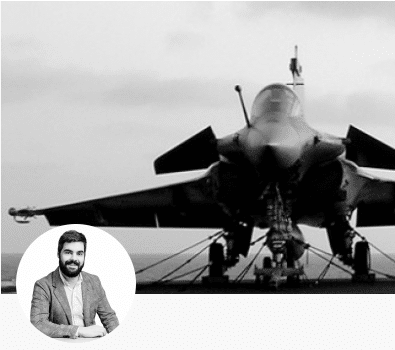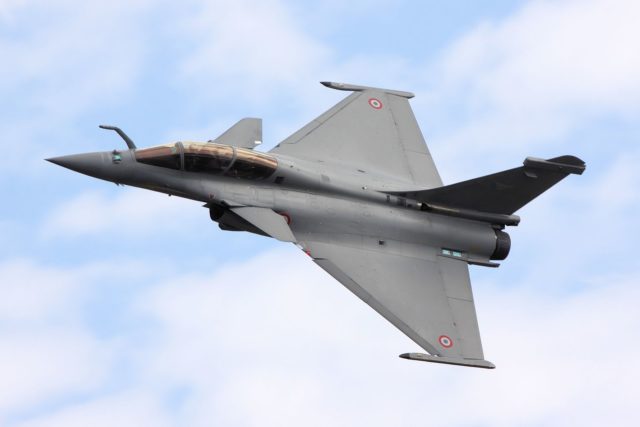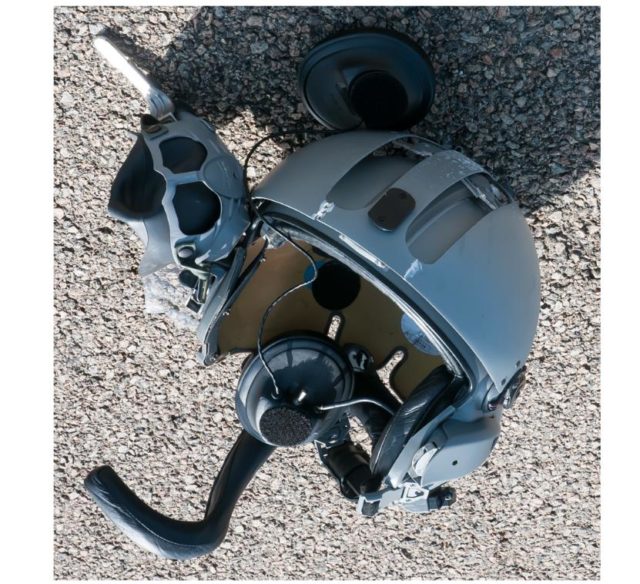64-year-old Civilian Ejects Himself from Dassault Rafale B Fighter Jet

Last Wednesday, aviation journalist Clement Charpentreau at Aerotime News shared this hard-to-believe French report involving a French civilian who managed to eject himself from a military jet on a surprise flight given to him as a retirement gift. I loved it and wanted to share it with all of you, so I mailed Clement, who was kind enough to allow me to reprint his brilliant translation and summary of the accident report. What I didn’t expect was that everyone else would think exactly the same thing, leading to the story running in various publications all over the world. Even my mother sent me a link.
Still, maybe not everyone has seen it and besides, most of the articles are a quick summary of the situation. I still think it is worth reading Clement’s original translation of this military mishap in which a civilian managed to eject himself from a Dassault Rafale B.
The gentleman in question worked for a defence contractor (I can’t help but wonder if it was Thales, where I used to write science fiction for workshops on innovation). It’s pretty unbelievable; one of my favourite things about Clement’s translation is how he slowly shifts from “passenger” to “victim”. If you read French, you can download the original report from the BEA
-S.

Fighter jet crash averted by defect in civil ejection incident
by CLEMENT CHARPENTREAU
Originally published on Aerotime News
On March 20, 2019, a civilian passenger was accidentally ejected from a twin-seat Rafale B fighter jet as the aircraft was taking off from Saint-Dizier 113 airbase, eastern France. The final report of the French investigation bureau for State aviation safety (BEA-E) on the incident outlines a chain reaction of both human and technical failures, one of which unexpectedly prevented the fighter jet from crashing.

Passenger unprepared and mishandled
The civilian passenger, identified by the report as a 64-year-old employee of a French defense manufacturer, was offered a discovery flight on a Dassault Rafale B fighter jet as a surprise by four of his colleagues, including a former pilot of the French Air Force that organized the gift.
Journalists or elected officials are often invited to take part in “observation” flights approved by the Ministry of the Armed Forces, for information and communication purposes. They must follow a strict procedure that includes a medical visit to the Center for medical expertise of flight personnel (CEMPN), and the approval of the Ministry.
However, this time, due to the “informal” setting of the flight, the usual protocol was not respected. Instead, the passenger was examined by a doctor four hours before the flight. He was declared apt to participate in the flight, under the condition that he would not be submitted to a negative load factor. That information was not communicated to the pilot.
The civilian was already nervous when he entered the cockpit, with his heart rate recorded between 136 and 142 beats per minute. The investigation found that the safety checks of the passenger had been approximate at best. He carried out most of his installation into the cockpit by himself. As a consequence, his visor was up, his anti-g pants were not worn properly, his helmet and oxygen mask were both unattached, and his seat straps were not tight enough.
Following orders of a regular training mission that involved two other Rafales, the pilot took off and climbed at 47°, generating a load factor of around +4G. Then, as he leveled off, he subjected his passenger to a negative load factor of about -0.6G.
“Discovering the feeling of the negative load factor, the insufficiently strapped and totally surprised passenger held onto the ejector handle and activated it unintentionally,” states the report. During the ejection, the civilian lost his helmet and oxygen mask. Due to a technical flaw of the seat, the dinghy failed to inflate, but fortunately, the incident happened above land. The passenger sustained minor injuries.
The BEA-E states that the absence of experience and the lack of preparation due to the surprise caused a lot of stress on the passenger, who had “never expressed a desire to carry out this type of flight, and in particular on Rafale”. The victim said he was given close to no possibility to refuse the flight from the moment it was announced to him. The social pressure of his colleagues also contributed to the stress.
Technical flaw saves the aircraft
Additionally to the mishandling of the passenger, the incident revealed something else: a malfunction of the ejection seat.
The fighter jet was set up to, under normal conditions, eject both the pilot and his passenger when one of them pulls on the ejection handle. The BEA-E explains the procedure of a Rafale double ejection in four stages: first, the back canopy is shattered by a line of explosives embedded into the glass, before the passenger seat is ejected. Then, the front canopy is also destroyed, and the pilot seat is the last to leave the fighter jet.
But in this case, the last stage failed and, despite his canopy being ejected, the pilot remained in his seat. Local media reported at the time that the glass of the canopy had slightly injured his hands. Nonetheless, he remained master of his aircraft. “He then remained calm to pilot his plane despite the multitude of failure messages that the on-board computer displays and an unusual aircraft centering following the loss of the rear seat and the canopy,” says the investigation, which analyzed the radio recordings.
Strictly following the safety procedure, he set his transponder on 7700, avoided flying over inhabited areas, dumped fuel and landed successfully back at the airbase. He then evacuated the cockpit by himself, fearing that the ejection seat could activate at any time. A safety perimeter was established around the Rafale for 24 hours, after which the ejection seat was defused.
The technical investigation found that the explosion ruptured the casing of the sequence selector supposed to trigger the pilot ejection seat. As for the uninflated dinghy of the passenger, it was obstructed by the incorrect folding of its container.
The BEA-E produced several recommendations in order to address both the unpreparedness of the passenger and the two technical flaws revealed by the incident. Among them, it reminded the military authorities and Dassault Aviation that a delay of 10 days should be respected between the medical visit and the flight, which gives enough time for the passenger to prepare both physically and mentally, as well as ensures medical recommendations reach the flight crew.

I love how petulantly the passenger victim says he never actually wanted a flight like this, especially not on a Rafale! I’d ask for his seat but not if I’m going to get thrown out of the plane mid-flight!
I’d like to thank Clement and Aerotime one more time for allowing me to share his great article. If you want to make my day, tell me that you hadn’t already read it elsewhere. :)








No Sylvia, this is the first time for me! :-)
When I was in my teens there was an airshow, I cannot remember where. All I know is: somewhere in the Netherlands, possibly at Valkenburg, a Dutch naval air force base.
There was a contraption for the training of air force pilots in the use of the ejection seat. The “victim” would be strapped into a fighter pilto’s seat and the vic… sorry, the trainee, would reach out over his head (I don’t think that there were female fighter pilots then) and pull a sort of flap over the helmet and over his face.
This would trigger the ejection sequence. On the training device, the trainee would be shot upwards to appoximately 60 feet. The seat was attached to a set of near-vertical rails.
Civilians were offered a chance to try it and “muggins” here thought that it would be a nice idea to take them up on the offer.
I was thoroughly strapped in and my legs were held together by another strap. The sequence was initiated by myself. Even though I had seen it in action with people trying it before me, I must admit that the violence of the simulated ejection came as a very nasty surprise. I thought that my vertebrae would compress.
To have it happen unexpectedly, without proper training, during a real flight – not ending 60 feet up on top of a rail, but dangling from a parachute certainly does not sound like fun to a 64 year old civilian. It does not to me, that is for sure.
The pilot, even though he did not cover himself in glory, participating in this caper, must still be congratulated on his handling of the flight after the passenger had been ejected.
Martin-Baker had one of these as a trainer.
THANK YOU!
I had heard snippets and a link to the investigation report, but my French doesn’t get past “a la mode”
Thanks for fleshing this out and getting the details.
I’m absolutely amazed (and happy) that he wasn’t severely injured by the ejection.
I guess there’s a first time for everything!
I’ll bet he won’t be flying a military jet again.
My first time commenting here. Also the first time I have heard about this incident. Heard of a similar situation that has happened in my country and wondering could I share a link for that (also very interesting) story. Good job Sylvia!
Brilliant story. 😎
Does he qualify as a Caterpillar under these circumstances?
Sorry, but read it elsewhere, however your extra photos and research bring it to life. There are a million French expressions one could use (they are pretty laid back after all), but this laissez faire attitude has no place in military aviation. How the passenger was not seriously injured, or even killed, was pure je ne sais quois. Apologies for my terrible use of French – but that’s as close as I could get! A complete re-vamp and strengthening of procedures around untrained passenger flights? As a bare minimum. Also a good look at maintenance procedures on ejection seats would be in order as well.
To the best of my knowledge, “untrained passenger flights” in miltary fighter jets are not tolerated, certainly not without a lot of “red tape”.
My praise of this particular pilot refers ONLY to his subsequent superb demonstration of “sang froid” and handling skills.
I most certainly do not applaud the part before. Even if we (members of the Tiger Club in the ‘seventees) took a passenger in a Tiger Moth or a Stampe, we always took care that the passenger would be strapped in properly. Especially in the Stampe. This had an inverted fuel system and an extra seat belt that made sure that the passenger (as well as the pilot) would be firmly attached to their seat, but also as extra security to attach them to the airframe. Before strapping them in, the seat would be put in a lower position, after all the straps were secure there was a handle beside the seat with which it could be raised, anchoring them firmly in place. This because the SV 4 was a far more responsive aircraft than the Tiger and very few, if any pilots could resist the odd roll, loop or even a more prolonged inverted flight.
In all cases the passenger would be eager to have a flight in an open biplane, they would never be coerced.
Violations could result in a ban by the club manager, Michael Jones.
Looks like the only thing that saved this from being a worse disaster was an Act of God and a malfunction that prevented the pilot from also being ejected.
It sounds like the Rafale got a testing of various systems that don’t ordinarily get tested.
(I’d read a shorter account on Facebook – but this had a lot of details that didn’t.)
Keyan certainly does make a valid point, but it should not have been the job of an “untrained civilian passenger” to find the fault, involuntarily.
I agree with John McLean: this could indeed have led to a tragedy. It is very fortunate that it can be presented here as a funny incident.
Interesting to me Rudy are ejection seats, their operation and maintenance. Obviously a specialised field with explosives handling qualifications. You can’t test a seat by firing it obviously, so a propellant replacement period must be established I guess. At that time maybe other components are checked and replaced as necessary, maybe also on a TBO basis. An interesting/expensive subject someone may know more about. It is why many warbirds are grounded which are otherwise airworthy.
Pax not familiar with flying will be more stressed, especially on such flight in a high performance aircraft.
Although the briefing should include emergency procedures, once in the plane, it is best to now focus on the “This is what you can touch, and where your hands should be if you are uncomfortable “.
It appears that the Air Force, the pilot and the mechanic were all complacent.
I have to wonder about the motives of the colleagues who appear to have pressured the passenger into accepting a “gift” that he didn’t want. Was it really done with good intentions, or were they secretly laughing at the thought of how much he would hate being thrown around in a Rafale?
Sylvia, tell us about your time writing science-fiction for Thales, that sounds like a good story!
Haha, a bit off subject but there’s more info here:
MenTour Pilot covered this amazing story on his Facebook channel.
I’m grateful both passenger and pilot are well, and live to fly another day.
Also, the lovely Rafale remains intact. 🛬
Sorry Sylvia, I had heard the story before. But your post is by far the best and most detailed description – as usual.
It was even mentioned on UK TV comedy show Have I Got News For You and of course everyone found it amusing. Now I’ve seen all the details I realise that this catalogue of many small errors very nearly resulted in two deaths and a written off aircraft – not really a laughing matter at all.
I was actually thinking of a plane crashing in a populated area.
John McLean,
I am no expert on ejection seats. The one I did refer to was a device to train pilots, to subect them to the force of being, quite literally, shot out of a fighter aircraft. I have only a memory of that part that involved being strapped into an ejector seat, or something looking like one and, after having been briefed and the position of the volunteer and the apparatus having been checked, given the signal to pull the flap over the head.
The force was much greater than I had anticipated. I guess that the height of the rail was about 60 feet,or maybe less. Was the propellant even an explosive cartridge, or was it compressed air? No idea. But I do remember thinking that if I were to sign up for the air force (I did not, my results for maths were not great), the training for the ejection seat was not going to be something to look forward to.
I mentioned that as a member of the Tiger Club there were strict rules about taking passengers up for aerobatics. Mainly being: they had to be told beforehand and the pilot had to make absolutely certain that the passenger would be securely strapped in.
If he or she indicated that (s)he was uncomfortable the session had to be stopped. The Tiger Moth did not have an electrial intercom, we could communicate via so-called “Gosport tubes”. The sound could travel adequately through plastic tubes, ine in a mask and the other set connected to ear pieces. Later battery-operated intercoms came into use. Neither the Tiger Moth nor the Stampe had electrical systems.